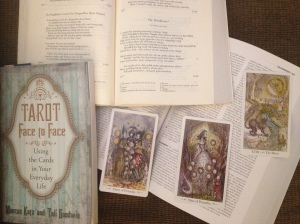Interpreting symbols in both poetry and Tarot involves crossing lines. To ease your passage (and become a better Tarot reader and poet), you can use the techniques of bridging and enjambment.
In their book Tarot Face to Face, Marcus Katz and Tali Goodwin define bridging as:
visually and/or intuitively connecting the symbols of the cards in a way that makes sense in the context of a reading.
In other words, cards are read collectively to create a new meaning that goes beyond simply listing the meanings of individual cards.
Bridging can be compared to the literary device of enjambment. Enjambment is when a sentence flows onto another line—grammatically, the sentence ends in the middle of a line. This is the opposite of an end-stopped line: a line that ends with a period, question mark, or exclamation point.
A poem that is famous for its enjambment is “The Windhover” by Gerard Manley Hopkins, which begins:
I caught this morning morning’s minion, king-
dom of daylight’s dauphin, dapple-dawn-drawn Falcon, in his riding
Of the rolling level underneath him steady air, and striding
High there, how he rung upon the rein of a wimpling wing
In his ecstasy! then off, off forth on swing,
As a skate’s heel sweeps smooth on a bow-bend: the hurl and gliding
Rebuffed the big wind. My heart in hiding
Stirred for a bird, – the achieve of, the mastery of the thing.
Hopkins splits a word across two lines (king-dom), setting up the reader to see the rest of the enjambment in the poem. Enjambment allows you to read to the period or to the line (to the grammatically sectioned off sentence or to the ideas sectioned off by line breaks). For instance, you can read grammatically, to the period:
Then off, off forth on swing, as a skate’s heel sweeps smooth on a bow-bend: the hurl and gliding rebuffed the big wind.
Or you can read a line as a sentence:
Rebuffed the big wind, my heart in hiding.
In the grammatical sentence, the gliding and hurl (actions of the bird) are what rebuffs the wind. However, in the sentence that the line creates, it is the “heart in hiding” that rebuffs the wind. Looking at both together develops the connection between heart, bird, and wind.
By connecting symbols across poetic lines, enjambment is very similar to bridging in Tarot. Lines are individual cards, groups of cards are stanzas, and the entire spread is a poem. I pulled some cards from Paulina Cassidy’s Tarot deck to demonstrate how to apply enjambment to your Tarot readings.
 Here, there is a multiplication of pentacles, a building of financial and earthly success. The bird (the windhover of this reading) that sits atop the head of the middle figure in the Three of Pentacles grows to become the much larger bird atop the head of the woman in the Nine of Pentacles. The other figures disappear, hinting at the cost of focusing on success (perhaps making her a “heart in hiding”).
Here, there is a multiplication of pentacles, a building of financial and earthly success. The bird (the windhover of this reading) that sits atop the head of the middle figure in the Three of Pentacles grows to become the much larger bird atop the head of the woman in the Nine of Pentacles. The other figures disappear, hinting at the cost of focusing on success (perhaps making her a “heart in hiding”).
The Moon overlooks the earthly matters of the now-solitary woman, as if its rays are shining behind her. She has the backing of the unknown, supported by mad mysteries that her former friends may not understand. This may be why the figures have left. But she succeeds without them, venturing into the night, along the path of the river.
